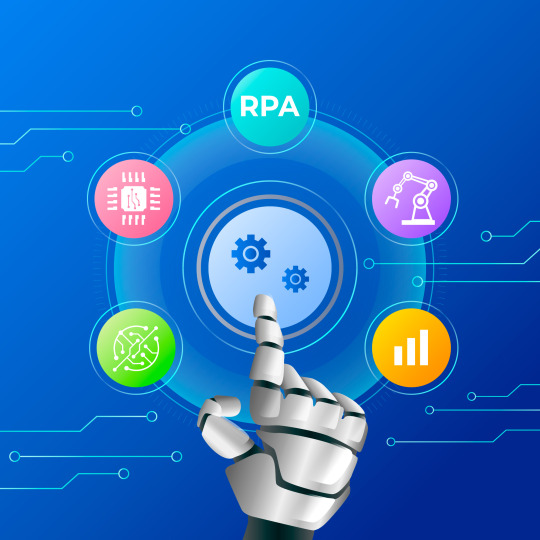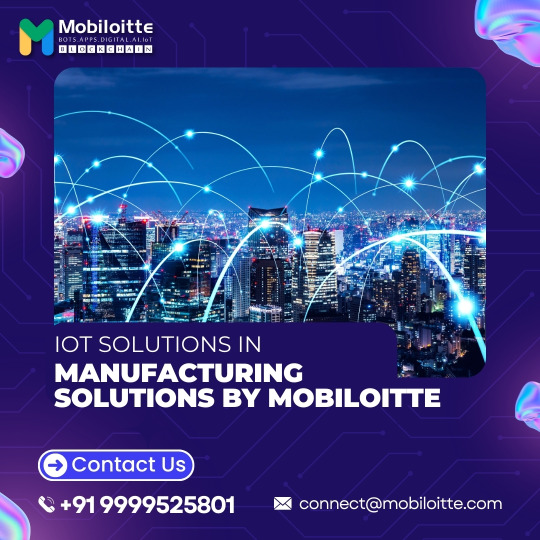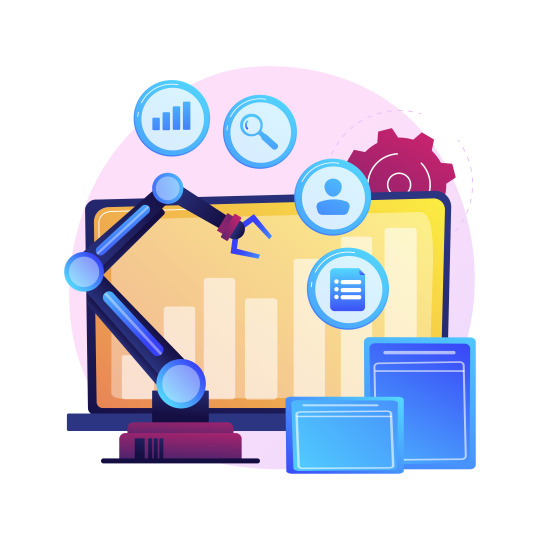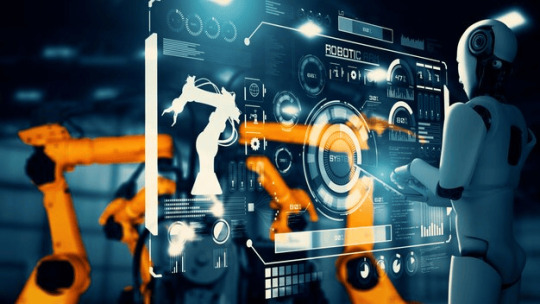#robotic process automation solution
Explore tagged Tumblr posts
Text
Unlocking Efficiency and Innovation: The Role of Robotic Process Automation (RPA)

In today's fast-paced and competitive business environment, organizations are constantly seeking ways to improve efficiency, reduce costs, and increase productivity. Robotic Process Automation (RPA) has emerged as a powerful tool that can help businesses achieve these objectives.
What is Robotic Process Automation (RPA)?
Robotic Process Automation (RPA) is a technology that allows businesses to automate repetitive, rule-based tasks. It uses software robots, also known as "bots," to mimic human actions and interact with digital systems. These bots can log into applications, navigate through screens, input data, and complete tasks just like humans would.
The Role of RPA in Business:
RPA can be used to automate a wide range of tasks across various industries and departments. Here are some examples:
Finance and Accounting: Automating tasks such as accounts payable and receivable, invoice processing, and financial reporting.
Customer Service: Automating tasks such as answering FAQs, resolving customer inquiries, and processing orders.
Human Resources: Automating tasks such as onboarding new employees, processing payroll, and managing benefits.
IT: Automating tasks such as provisioning accounts, managing user access, and deploying software updates.
Impact of RPA on Businesses:
Implementing RPA can offer numerous benefits to businesses, including:
Increased efficiency and productivity: RPA can automate time-consuming and tedious tasks, freeing up employees to focus on more strategic and value-added activities.
Reduced costs: RPA can help businesses save money on labor costs, as well as reduce errors and compliance risks.
Improved accuracy and compliance: RPA bots are programmed to follow specific rules and procedures, which can help to improve accuracy and compliance with regulations.
Enhanced process visibility and control: RPA provides businesses with a clear view of their processes, which can help them identify and address bottlenecks.
Improved customer satisfaction: RPA can help businesses improve customer satisfaction by automating tasks such as order processing and customer service interactions.
RPA Services:
Implementing RPA successfully requires a partner with expertise in the technology and a deep understanding of business processes. A comprehensive RPA solution should include the following services:
Document AS-IS Process: This involves mapping out the existing process to identify areas for automation.
Design & Development of Bots, workflows, and forms for process automation: This includes designing and developing the software robots that will automate the tasks.
Bot license (We will use the appropriate underlying technology): This provides access to the software robots and the underlying technology platform.
Infrastructure: This includes setting up the necessary infrastructure to support the Robotic Process Automation (RPA) solution.
Production Deployment of the Bots: This involves deploying the bots to production and monitoring their performance.
RPA support: This includes ongoing support for the RPA solution, such as troubleshooting and maintenance.
Test & Deploy bots to production: This involves testing the bots in a production environment and making any necessary adjustments before they are deployed to full production.
Configuration data changes: This involves making changes to the configuration data of the bots as needed.
Password updates: This involves updating the passwords of the bots as needed.
Errors in executing the Bots: This involves resolving errors that occur during the execution of the bots.
Determining the “root cause” of a recurring issue or incident & recommendations: This involves identifying the root cause of a recurring issue or incident and recommending solutions to prevent it from happening again.
Infrastructure/application related issues: This involves resolving issues with the infrastructure or applications that the bots are interacting with.
Conclusion:
RPA is a powerful technology that can have a significant impact on businesses of all sizes. By automating repetitive tasks, RPA can help businesses improve efficiency, reduce costs, and increase productivity. However, it is important to choose a reputable Robotic Process Automation (RPA) companies with the expertise and experience to help you implement a successful RPA solution.
Ready to embrace the power of RPA?
Contact us today to learn more about how RPA can help your business achieve its goals.
#robotic process automation#robotic process automation rpa#rpa automation#robotic process automation software#rpa software#robotic process automation companies#robotic process automation technology#robotic process automation in healthcare#robotic process automation in banking#rpa solution#robotic process automation for finance#process automation solution#robotic process automation services#robotic process automation for insurance#rpa system#what is rpa automation#robotic process automation solution#robotic process automation benefits#robotic process automation consulting#robotic process automation consultant#rpa service provider#rpa consulting services
2 notes
·
View notes
Text
How Robots Revolutionize Distribution Center Management

In the ever-evolving landscape of supply chain management, distribution centers play a pivotal role in ensuring seamless movement of goods from manufacturers to consumers. With the surge in e-commerce and customer expectations for faster deliveries, distribution centers are under immense pressure to optimize their operations. In this quest for efficiency, robots have emerged as indispensable allies. Let’s delve into how robots are transforming distribution center management. Automated Material Handling:
Robots are adept at handling repetitive and labor-intensive tasks such as material movement. Automated Guided Vehicles (AGVs) and Autonomous Mobile Robots (AMRs) navigate through the warehouse, transporting goods from one location to another with precision and speed. By automating material handling, robots minimize the risk of errors and accidents while significantly reducing operational costs. Inventory Management:
Maintaining accurate inventory records is crucial for distribution centers to meet customer demands effectively. Robots equipped with advanced sensors and computer vision capabilities can conduct inventory audits autonomously. They traverse through aisles, scanning barcodes, and RFID tags to identify discrepancies in stock levels. This real-time data enables managers to make informed decisions regarding replenishment and stock allocation. Integration with AI and IoT:
The integration of robotics with artificial intelligence (AI) and the Internet of Things (IoT) amplifies their capabilities and unlocks new possibilities for distribution center management. AI algorithms optimize robot navigation and task allocation, continuously learning from real-time data to improve efficiency and performance. IoT sensors embedded in robots and warehouse infrastructure enable seamless communication and coordination, facilitating synchronized operations and enabling predictive maintenance. Order Fulfillment:
Fulfilling customer orders promptly is paramount in the age of instant gratification. Robots streamline the order fulfillment process by picking, packing, and shipping items with remarkable efficiency. Collaborative robots, or cobots, work alongside human workers in pick-and-pack operations, accelerating order processing while ensuring ergonomic work conditions. Moreover, robotic picking systems powered by machine learning algorithms optimize pick routes, minimizing travel time within the warehouse. Warehouse Optimization:
The layout and organization of a warehouse significantly impact operational efficiency. Robots aid in warehouse optimization by analyzing data on order volume, SKU velocity, and seasonal trends to optimize storage configurations. Additionally, robotic systems facilitate dynamic slotting, allowing distribution centers to adapt to changing demand patterns swiftly. By maximizing space utilization and minimizing congestion, robots enhance throughput and scalability. Predictive Maintenance:
Downtime due to equipment failure can disrupt operations and incur substantial losses. Robots integrated with predictive maintenance algorithms monitor the health of machinery and conveyor systems in real-time. By detecting early signs of wear and tear, robots enable proactive maintenance interventions, preventing unexpected breakdowns. This predictive approach not only prolongs the lifespan of assets but also ensures uninterrupted workflow within the distribution center. Human-Robot Collaboration:
Contrary to the misconception of robots replacing human workers, the future of distribution center management lies in human-robot collaboration. While robots handle routine tasks and heavy lifting, human workers contribute their cognitive abilities, problem-solving skills, and creativity to more complex aspects of warehouse operations. This symbiotic relationship maximizes efficiency and productivity while empowering employees to focus on value-added activities that require human expertise. Labor Augmentation, Not Replacement:
Contrary to common misconceptions, the integration of robots in distribution centers does not entail the displacement of human workers. Instead, robots augment human labor by automating mundane tasks and reallocating employees to more value-added roles. By offloading repetitive responsibilities to robots, workers can focus on tasks that require creativity, problem-solving, and customer interaction. This symbiotic relationship between humans and robots fosters a more agile and productive workforce. Data-Driven Insights:
Robots generate a wealth of data throughout their operations, offering valuable insights into warehouse performance. Analytics tools analyze this data to identify bottlenecks, optimize workflows, and forecast future demand accurately. By leveraging data-driven insights, distribution center managers can implement continuous improvement initiatives, driving operational excellence and competitive advantage in the market.
By analyzing this data, distribution center managers can identify inefficiencies, pinpoint areas for improvement, and make data-driven adjustments to enhance overall productivity and cost-effectiveness. Furthermore, predictive analytics algorithms can anticipate maintenance needs or potential bottlenecks, enabling proactive interventions to prevent disruptions. Optimization of Space:
Maximizing storage space is crucial in distribution centers, and robots play a pivotal role in achieving this optimization. With their ability to maneuver through narrow aisles and stack goods vertically, robots make efficient use of every square foot of available space. Moreover, advanced algorithms enable robots to analyze inventory data and dynamically reconfigure storage layouts for optimal accessibility and organization, further streamlining operations. Scalability and Flexibility:
Distribution centers often face fluctuations in demand due to seasonal variations or unforeseen events. Robots offer scalability and flexibility to adapt to changing requirements seamlessly. Unlike fixed conveyor belts or manual labor, robots can easily be reprogrammed or redeployed to accommodate fluctuations in inventory volume or layout modifications. Whether it’s ramping up operations during peak seasons or reconfiguring workflows to accommodate new product lines, robots enable distribution centers to scale their operations efficiently without compromising on quality or speed. By deploying additional robots or reconfiguring existing systems, distribution centers can rapidly adapt to changing requirements and maintain operational agility in a competitive market landscape.
Enhanced Safety:
Safety is paramount in warehouse environments where heavy machinery and human workers coexist. Automated guided vehicles (AGVs) and autonomous mobile robots (AMRs) navigate through warehouses with precision, retrieving and transporting goods with minimal human intervention. Robots are equipped with advanced safety features such as collision detection sensors and emergency stop mechanisms to prevent accidents. By automating hazardous tasks and adhering to strict safety protocols, robots create a safer working environment for employees, reducing the risk of workplace injuries and ensuring regulatory compliance.
In conclusion, robots are revolutionizing distribution center management by optimizing processes, enhancing efficiency, and empowering human workers. From automated material handling to predictive maintenance, robots offer a myriad of benefits that translate into cost savings, improved customer satisfaction, and competitive advantage. As technology continues to advance and robotic systems evolve, distribution centers will become increasingly agile, adaptive, and efficient, setting new standards for supply chain excellence in the digital age. Embracing robotic technologies is not just about embracing innovation; it’s about future-proofing distribution centers to thrive in an increasingly dynamic marketplace. Original Source:https://trendingblogsweb.com/how-robots-revolutionize-distribution-center-management/
0 notes
Text
Transforming Business Operations with RPA in Dubai Process Automation
In today's fast-paced digital landscape, businesses face increasing pressure to optimize operations, enhance efficiency, and drive productivity. Robotic Process Automation (RPA) emerges as a transformative technology that leverages intelligent software robots to automate repetitive, rule-based tasks—enabling organizations to streamline workflows, reduce errors, and achieve significant cost savings. With our expertise in robotic process automation and deep industry knowledge, Centelli empowers businesses in Dubai to unlock their full potential through the implementation of cutting-edge RPA process automation solutions.
With the UAE’s ongoing push to bolster its status as a global business hub, AI and automation are set to play a pivotal role. The adoption of these technologies has gained steady traction in recent years—and it’s expected to accelerate further as the government rolls out ambitious innovation and digital transformation plans.
The evolution isn’t limited to the public sector alone. It’s actively reshaping businesses across various industries. Moreover, as use cases, tools, and solutions continue to advance, many exciting new concepts are emerging.
Top Automation AI Trends to Know in 2025
In a market like the UAE—driven by ambition and innovation—staying ahead of the curve is crucial!
Whether you’re a business, an organization, a leader, or part of the workforce, the following AI automation trends are worth noting. And they’re making waves worldwide:
AI-Enhanced RPA
Intelligent Automation
Digital Workers
Hyperautomation
Agentic AI
If You’re a UAE Business Looking to Leverage AI / Automation
Whether you seek operational efficiency, real-time decisions, an empowered workforce, or streamlined costs, please understand: AI and automation aren’t one-size-fits-all solutions. Every organization should approach them based on its own complexity, resources, and goals.
As trusted partners of UiPath (Automation) and Soroco (AI), we at Centelli provide custom-crafted solutions that deliver real results. Book a free, no-obligation online meeting with us today.
#AI Solutions#Intelligent Automation#Robotic Process Automation#Digital Worker#Dubai#Centelli#UAE#RPA in Dubai#UiPath
0 notes
Text
Revolutionize Traditional Operations with Robotic Process Automation

Traditional business models can’t survive in today’s fast-paced economy. Robotic Process Automation (RPA) offers a practical, affordable way to modernize and scale. An RPA solution eliminates manual bottlenecks by automating everyday tasks like data entry, payroll, and customer service. This means faster response times, fewer errors, and lower operational costs. Whether you're in manufacturing, retail, or logistics, RPA helps you adapt and thrive. At ESS, we customize RPA services for real-world business challenges—ensuring a smooth digital transformation. Say goodbye to inefficiencies and hello to a smarter way of working. Discover how RPA can future-proof your operations today.
0 notes
Text
How AI Is Revolutionizing Contact Centers in 2025
As contact centers evolve from reactive customer service hubs to proactive experience engines, artificial intelligence (AI) has emerged as the cornerstone of this transformation. In 2025, modern contact center architectures are being redefined through AI-based technologies that streamline operations, enhance customer satisfaction, and drive measurable business outcomes.
This article takes a technical deep dive into the AI-powered components transforming contact centers—from natural language models and intelligent routing to real-time analytics and automation frameworks.
1. AI Architecture in Modern Contact Centers
At the core of today’s AI-based contact centers is a modular, cloud-native architecture. This typically consists of:
NLP and ASR engines (e.g., Google Dialogflow, AWS Lex, OpenAI Whisper)
Real-time data pipelines for event streaming (e.g., Apache Kafka, Amazon Kinesis)
Machine Learning Models for intent classification, sentiment analysis, and next-best-action
RPA (Robotic Process Automation) for back-office task automation
CDP/CRM Integration to access customer profiles and journey data
Omnichannel orchestration layer that ensures consistent CX across chat, voice, email, and social
These components are containerized (via Kubernetes) and deployed via CI/CD pipelines, enabling rapid iteration and scalability.
2. Conversational AI and Natural Language Understanding
The most visible face of AI in contact centers is the conversational interface—delivered via AI-powered voice bots and chatbots.
Key Technologies:
Automatic Speech Recognition (ASR): Converts spoken input to text in real time. Example: OpenAI Whisper, Deepgram, Google Cloud Speech-to-Text.
Natural Language Understanding (NLU): Determines intent and entities from user input. Typically fine-tuned BERT or LLaMA models power these layers.
Dialog Management: Manages context-aware conversations using finite state machines or transformer-based dialog engines.
Natural Language Generation (NLG): Generates dynamic responses based on context. GPT-based models (e.g., GPT-4) are increasingly embedded for open-ended interactions.
Architecture Snapshot:
plaintext
CopyEdit
Customer Input (Voice/Text)
↓
ASR Engine (if voice)
↓
NLU Engine → Intent Classification + Entity Recognition
↓
Dialog Manager → Context State
↓
NLG Engine → Response Generation
↓
Omnichannel Delivery Layer
These AI systems are often deployed on low-latency, edge-compute infrastructure to minimize delay and improve UX.
3. AI-Augmented Agent Assist
AI doesn’t only serve customers—it empowers human agents as well.
Features:
Real-Time Transcription: Streaming STT pipelines provide transcripts as the customer speaks.
Sentiment Analysis: Transformers and CNNs trained on customer service data flag negative sentiment or stress cues.
Contextual Suggestions: Based on historical data, ML models suggest actions or FAQ snippets.
Auto-Summarization: Post-call summaries are generated using abstractive summarization models (e.g., PEGASUS, BART).
Technical Workflow:
Voice input transcribed → parsed by NLP engine
Real-time context is compared with knowledge base (vector similarity via FAISS or Pinecone)
Agent UI receives predictive suggestions via API push
4. Intelligent Call Routing and Queuing
AI-based routing uses predictive analytics and reinforcement learning (RL) to dynamically assign incoming interactions.
Routing Criteria:
Customer intent + sentiment
Agent skill level and availability
Predicted handle time (via regression models)
Customer lifetime value (CLV)
Model Stack:
Intent Detection: Multi-label classifiers (e.g., fine-tuned RoBERTa)
Queue Prediction: Time-series forecasting (e.g., Prophet, LSTM)
RL-based Routing: Models trained via Q-learning or Proximal Policy Optimization (PPO) to optimize wait time vs. resolution rate
5. Knowledge Mining and Retrieval-Augmented Generation (RAG)
Large contact centers manage thousands of documents, SOPs, and product manuals. AI facilitates rapid knowledge access through:
Vector Embedding of documents (e.g., using OpenAI, Cohere, or Hugging Face models)
Retrieval-Augmented Generation (RAG): Combines dense retrieval with LLMs for grounded responses
Semantic Search: Replaces keyword-based search with intent-aware queries
This enables agents and bots to answer complex questions with dynamic, accurate information.
6. Customer Journey Analytics and Predictive Modeling
AI enables real-time customer journey mapping and predictive support.
Key ML Models:
Churn Prediction: Gradient Boosted Trees (XGBoost, LightGBM)
Propensity Modeling: Logistic regression and deep neural networks to predict upsell potential
Anomaly Detection: Autoencoders flag unusual user behavior or possible fraud
Streaming Frameworks:
Apache Kafka / Flink / Spark Streaming for ingesting and processing customer signals (page views, clicks, call events) in real time
These insights are visualized through BI dashboards or fed back into orchestration engines to trigger proactive interventions.
7. Automation & RPA Integration
Routine post-call processes like updating CRMs, issuing refunds, or sending emails are handled via AI + RPA integration.
Tools:
UiPath, Automation Anywhere, Microsoft Power Automate
Workflows triggered via APIs or event listeners (e.g., on call disposition)
AI models can determine intent, then trigger the appropriate bot to complete the action in backend systems (ERP, CRM, databases)
8. Security, Compliance, and Ethical AI
As AI handles more sensitive data, contact centers embed security at multiple levels:
Voice biometrics for authentication (e.g., Nuance, Pindrop)
PII Redaction via entity recognition models
Audit Trails of AI decisions for compliance (especially in finance/healthcare)
Bias Monitoring Pipelines to detect model drift or demographic skew
Data governance frameworks like ISO 27001, GDPR, and SOC 2 compliance are standard in enterprise AI deployments.
Final Thoughts
AI in 2025 has moved far beyond simple automation. It now orchestrates entire contact center ecosystems—powering conversational agents, augmenting human reps, automating back-office workflows, and delivering predictive intelligence in real time.
The technical stack is increasingly cloud-native, model-driven, and infused with real-time analytics. For engineering teams, the focus is now on building scalable, secure, and ethical AI infrastructures that deliver measurable impact across customer satisfaction, cost savings, and employee productivity.
As AI models continue to advance, contact centers will evolve into fully adaptive systems, capable of learning, optimizing, and personalizing in real time. The revolution is already here—and it's deeply technical.
#AI-based contact center#conversational AI in contact centers#natural language processing (NLP)#virtual agents for customer service#real-time sentiment analysis#AI agent assist tools#speech-to-text AI#AI-powered chatbots#contact center automation#AI in customer support#omnichannel AI solutions#AI for customer experience#predictive analytics contact center#retrieval-augmented generation (RAG)#voice biometrics security#AI-powered knowledge base#machine learning contact center#robotic process automation (RPA)#AI customer journey analytics
0 notes
Text

IoT Solutions in Manufacturing Solutions by Mobiloitte
#Advanced Manufacturing Solutions#Manufacturing Innovation#Manufacturing Technology#Smart Manufacturing#Industrial Automation#Manufacturing Efficiency#Production Optimization#Digital Manufacturing#Manufacturing Industry Solutions#Robotics in Manufacturing#AI in Manufacturing#Manufacturing Process Improvement#IoT in Manufacturing#Manufacturing Software#Global Manufacturing Innovation#Advanced Production Techniques.
0 notes
Text
Leveraging AI in Robotic Test Automation for Smarter Testing Processes
Artificial Intelligence (AI) is revolutionizing robotic test automation by enabling smarter, more efficient testing processes. Here’s how AI enhances test automation:
Intelligent Test Case Generation
AI algorithms analyze application behaviour and user interactions to identify critical test scenarios. This eliminates guesswork and ensures comprehensive coverage with minimal manual intervention.
Self-Healing Automation Scripts
AI-powered automation can detect and adapt to changes in application UI or workflows, ensuring scripts remain functional even after updates. This reduces maintenance efforts and downtime.
Predictive Analytics
AI tools analyze historical data to predict potential failure points and prioritize high-risk areas for testing. This targeted approach optimizes resource allocation and improves efficiency.
Enhanced Accuracy and Efficiency
By automating repetitive and complex tasks with precision, AI eliminates human errors, accelerates execution, and improves the reliability of test outcomes.
Visual and Cognitive Testing
AI enables visual recognition and natural language processing for testing complex UI elements and voice/text-based interfaces, making it ideal for modern applications.
Continuous Learning
AI systems continuously learn from test data, improving decision-making and test case relevance over time.
Integrating AI into robotic test automation empowers QA teams to deliver smarter, faster, and more reliable testing, ensuring high-quality software in dynamic development environments.
#robotic test automation solution#robotic automation solution#robot framework web automation#mainframe automation using robot framework#robotics process automation testing#web automation using robot framework#warehouse automation robots
0 notes
Text
Top Robotic Process Automation Service Providers Revolutionising Business Efficiency

In today’s competitive landscape, organisations are constantly seeking ways to improve efficiency, reduce operational costs, and enhance overall productivity. One of the most impactful solutions in this regard is Robotic Process Automation (RPA). With its ability to automate repetitive tasks, streamline processes, and minimise human error, RPA has become a critical tool for modern businesses. In this article, we delve into the top robotic process automation service providers who are transforming the way businesses operate and driving unparalleled efficiency.
The Importance of Robotic Process Automation
Before exploring the service providers, it’s essential to understand why RPA has become a cornerstone for businesses aiming to stay ahead in their respective industries:
Enhanced Productivity: By automating routine tasks, RPA frees up human resources to focus on high-value, strategic activities. Employees can dedicate more time to creative and analytical work, driving innovation and growth.
Cost Savings: Automated processes significantly reduce labour costs and improve the overall cost-efficiency of operations. This reduction allows businesses to allocate resources more effectively, improving profitability.
Error Reduction: With consistent and rule-based execution, RPA minimises errors associated with manual tasks. This ensures higher accuracy in critical operations like data entry, reporting, and compliance checks.
Scalability: RPA solutions can easily scale to accommodate the growing needs of a business, making them a flexible choice for organisations of all sizes. From startups to multinational corporations, scalability ensures sustainability.
Improved Compliance: Automated systems ensure adherence to regulations and standards, reducing compliance risks. With comprehensive audit trails, organisations can easily verify and document processes.
Characteristics of Leading Robotic Process Automation Service Providers
Top robotic process automation service providers share common characteristics that set them apart. When selecting a provider, businesses should look for the following qualities:
Customisation Capabilities: The best providers tailor solutions to fit the unique needs of their clients. They prioritise understanding specific business challenges and delivering bespoke systems.
Comprehensive Support: A robust support system ensures smooth implementation and ongoing maintenance of RPA systems. This includes updates, troubleshooting, and staff training.
Advanced Technology: Providers leveraging cutting-edge AI and machine learning technologies deliver superior automation solutions. This ensures businesses remain competitive in an increasingly digital world.
Industry Expertise: Extensive knowledge of specific industries allows providers to design solutions that align with business goals. From retail to healthcare, industry expertise ensures targeted outcomes.
Proven Track Record: A track record of client satisfaction and successful implementation is a reliable indicator. Case studies and client testimonials often reflect the provider’s effectiveness.
Benefits Offered by Robotic Process Automation Service Providers
Choosing the right provider can have transformative effects on a business. Here are some key benefits of working with top RPA providers:
Faster Time-to-Market: Automated processes accelerate operations, enabling businesses to deliver products and services more quickly. This flexibility has the potential to revolutionise businesses that move quickly.
Increased Operational Efficiency: By streamlining workflows, providers help eliminate bottlenecks and redundancies. Businesses experience smoother processes and optimised resource use.
Enhanced Customer Experience: Faster, error-free operations lead to improved customer satisfaction. Automated customer interactions ensure consistency and responsiveness.
Data Insights: Many RPA tools come with analytics features, offering valuable insights into business processes. This data can guide strategic decisions and uncover new opportunities.
Flexibility Across Sectors: From healthcare to finance, RPA solutions are adaptable to a wide range of industries. Providers often specialise in addressing sector-specific pain points.
Key Applications of RPA Across Industries
Robotic process automation service providers cater to diverse industries by addressing specific pain points and delivering bespoke solutions. Below are some notable applications:
Finance and Accounting
Automating invoice processing and accounts reconciliation, reducing the time and effort required.
Streamlining financial reporting and auditing tasks to ensure compliance and accuracy.
Human Resources
Simplifying employee onboarding and payroll management, enhancing efficiency and employee satisfaction.
Automating compliance reporting and performance reviews, allowing HR teams to focus on strategic initiatives.
Customer Service
Enhancing query resolution through automated responses, reducing response times and improving customer satisfaction.
Reducing wait times with intelligent chatbots that handle routine inquiries and escalate complex issues.
Healthcare
Managing patient data and appointment scheduling, improving operational efficiency in clinics and hospitals.
Ensuring accurate claims processing and billing, reducing administrative overheads and errors.
Retail
Streamlining inventory management and supply chain operations, ensuring timely restocking and efficient logistics.
Enhancing personalised marketing efforts with data automation, leading to better customer targeting and increased sales.
Tips for Choosing the Right RPA Service Provider
Selecting the ideal robotic process automation service provider can be a daunting task. The following useful advice will help to streamline the decision-making process:
Assess Your Needs: Clearly define the processes you want to automate and your desired outcomes. Understanding your objectives will help you evaluate potential providers effectively.
Evaluate Expertise: Look for providers with experience in your industry and a strong understanding of your business challenges. This ensures they can deliver solutions that meet your unique requirements.
Check Integration Capabilities: Ensure the provider’s solutions integrate seamlessly with your existing systems. Compatibility is crucial for smooth operations and minimal disruptions.
Consider Scalability: Choose a provider with scalable solutions to support future growth. This ensures your investment remains valuable as your business evolves.
Request Case Studies: Reviewing past projects can provide insights into the provider’s capabilities and success rates. This also highlights their ability to meet deadlines and deliver quality results.
Emerging Trends in RPA
The field of RPA is continuously evolving, with new trends shaping the way robotic process automation service providers deliver their solutions. Among the most noteworthy trends are:
Hyperautomation: Combining RPA with AI, machine learning, and analytics for a more holistic approach to automation. This trend aims to tackle complex processes that require advanced decision-making capabilities.
Cognitive Automation: Introducing AI-driven bots capable of handling unstructured data and making decisions. This allows for more sophisticated automation in areas like customer service and fraud detection.
Cloud-Based RPA: Leveraging cloud platforms for greater flexibility and cost-effectiveness. Cloud-based solutions provide easier access, reduced infrastructure costs, and enhanced scalability.
Integration with IoT: Using RPA to manage IoT-enabled devices and systems. For sectors like manufacturing and logistics, this tendency is especially pertinent.
Focus on Security: Enhancing security protocols to protect sensitive data handled by automated systems. Information security is critical as automation grows in popularity.
The Future of RPA in Business
As organisations continue to embrace digital transformation, the role of robotic process automation service providers will become even more significant. The following forecasts are for the future:
Wider Adoption Across SMEs: More small and medium-sized enterprises will adopt RPA to compete with larger firms. Accessible and affordable solutions will drive this trend.
Greater Personalisation: Providers will focus on creating highly tailored solutions to meet individual business needs. This will guarantee optimal efficacy and relevance.
Integration with Emerging Technologies: RPA will work alongside technologies like blockchain, AI, and quantum computing for more advanced applications. This integration will open up new automation opportunities.
Focus on Sustainability: Automation will be leveraged to support eco-friendly initiatives and reduce waste. Businesses will prioritise sustainable practices through smarter resource management.
Enhanced Workforce Collaboration: The integration of human and digital workforces will create a harmonious and productive environment. Employees will work alongside bots to achieve higher efficiency.
Conclusion
Robotic process automation service providers play a pivotal role in revolutionising business efficiency by offering innovative solutions that address critical operational challenges. By choosing the right provider, businesses can unlock new levels of productivity, streamline workflows, and stay competitive in an ever-evolving market. As the RPA landscape continues to advance, the possibilities for innovation and growth are boundless, making it an exciting time for organisations to embrace automation and reap its numerous benefits.
In the years to come, businesses that prioritise automation will lead their industries, achieving unparalleled success and setting benchmarks for operational excellence. Whether it’s through enhanced customer experiences, reduced costs, or sustainable practices, RPA is shaping the future of work, making it an indispensable tool for modern enterprises.
#robotic process automation service providers#rpa solutions#robotic process automation tools#rpa automation tools#robotic process automation companies#robotic process automation solutions#robotic process automation companies in india#rpa service providers#robotic automation companies#robotic process automation vendors#rpa solution provider#top robotic process automation companies#top rpa service providers#rpa providers
0 notes
Text
#EPSON ROBOTS IN INDIA#Experience the Ultimate in Automation with Epson Robots' SCARA and 6-Axis Solutions.#Epson Robots takes industrial automation to the next level with its cutting-edge SCARA and 6-axis robots#catering to all your manufacturing needs. If you seek the perfect balance of affordability and exceptional performance#look no further than our LS-B Series SCARA Robots#featuring the LS3 and LS6 models. These robots are tailored to meet your high-value requirements without breaking the bank. Equipped with a#Epson Robots' solutions can efficiently tackle any task at hand.#Discover the Power of Versatile 6-Axis Robots#For those in need of a cost-effective and high-performance factory solution#our VT6 Series 6-Axis Robots are the ideal choice. Packed with an array of low-cost technologies and the unparalleled performance#flexibility#and reliability that our users have come to trust#these robots are set to revolutionize your manufacturing processes.#Your Perfect Robot Awaits - Explore Our T Series and LS Series SCARA Robots#We understand that finding the perfect robot for your factory is crucial#which is why we offer an extensive range of options and features. Whether you need a SCARA robot or a 6-axis solution#Epson Robots has just the right fit for your unique requirements. Connect with us today to learn more about our innovative T Series and LS
0 notes
Text
Factory Automation in pune | India
The total automation of the production process is what we mean when we talk about factory automation. Using technologies like robotic arms, hydraulic systems, and pneumatic systems to automate the construction of increasingly complicated systems is standard procedure in the manufacturing industry.
#Partner in Factory Automation#Electrical & software solutions#Process Automation Partner#Revolutionizing Process Automation#Transforming Automotive Manufacturing with Advanced Automation#WAGO Technical Solutions#Electrical & Electronic Interfaces#process automation robotics india
0 notes
Text
Transform Business Efficiency with Robotic Process Automation Solutions
Discover cutting-edge robotic process automation solutions at OliveQsol, designed to streamline workflows and enhance productivity. Our tailored RPA strategies automate repetitive tasks, reduce errors, and save time, empowering your business to focus on innovation and growth. OliveQsol’s expertise in robotic process automation solutions ensures seamless integration with your existing processes, driving operational excellence. Unlock your business’s potential with OliveQsol’s state-of-the-art RPA services today.
0 notes
Text
Unlock Business Growth with RPA in Dubai
Is your business still stuck with slow, manual processes? It’s time to rethink how you work. Discover how RPA in Dubai can streamline operations, reduce costs, and improve accuracy across your core business functions.
Robotic Process Automation (RPA) uses smart software robots to handle repetitive, rule-based tasks. It reduces human error, speeds up processes, and frees up your teams for high-value, strategic work. Businesses across the Gulf are increasingly automating key processes to improve quality, enhance output, and gain a competitive edge.
Why Invest in RPA in Dubai?
Dubai’s fast-paced, competitive business landscape demands smarter, faster processes. RPA solutions offer a simple, scalable, and cost-effective way to meet those demands while driving operational excellence.
Here’s what you can achieve with RPA implementation:
Automate repetitive, time-consuming tasks
Improve accuracy by eliminating manual errors
Lower operational costs and boost productivity
Scale operations without increasing your workforce
Allow teams to focus on value-adding, strategic work
Notably, these automation software bots can be deployed across multiple industries, including:
Banking and Insurance
Retail and e-Commerce
Healthcare and Hospital Management
Construction and Manufacturing
Logistics and Supply Chain
Automotive and Dealerships
Hospitality and Tourism
Whether it’s customer service, finance, HR, operations, or sales, RPA improves accuracy, speed, and efficiency across functions. This also enables companies to uplift the employee experience as mundane and repetitive work is taken off their plate.
At Centelli, we create and deliver custom RPA automation solutions in Dubai tailored to your unique business needs. We also offer AI-enabled RPA for intelligent automation. Serving clients across the UAE, UK, EU, US, and India. Book your free consultation today and experience the power of automation.
#AI Solutions#Intelligent Automation#Technology#Automation Solutions#Robotic Process Automation#RPA#Dubai#Centelli
0 notes
Text
Robotic Process Automation: Transforming Business Operations

Explore how RPA is revolutionizing industries by streamlining operations, enhancing data accuracy, and delivering faster results with minimal human intervention.
0 notes
Text

Gain a comprehensive understanding of BOAT (business orchestration and automation technologies). Navigate the future of business with our expert insights.
#boat#business orchestration and automation technologies#intelligent automation solutions#robotic process automation
0 notes
Text

Contact Power Automate Solutions: RPA Services for Enhanced Productivity (celebaltech.com)
#power automate solutions#robotic process automation solutions#rpa services#power automate consulting#microsoft power platform
0 notes
Text
StockHolding DMS- Reliable Robotic Process Automation Vendors

StockHolding DMS provides top-tier Robotic Process Automation vendors solutions that cater to various business requirements. Our offerings are designed to automate tasks, reduce errors, and improve overall efficiency. With a focus on quality and client satisfaction, we ensure that our RPA solutions are robust, scalable, and aligned with industry standards. Choose StockHolding DMS as your RPA vendor to enhance your business operations and achieve strategic goals. Visit Us- https://stockholdingdms.com/robotic-process-automation.php
#robotic process automation service providers#rpa solutions#robotic process automation tools#rpa automation tools#robotic process automation companies#robotic process automation solutions#robotic process automation companies in india#rpa service providers#robotic automation companies#robotic process automation vendors#rpa solution provider#top robotic process automation companies#top rpa service providers#rpa providers
0 notes